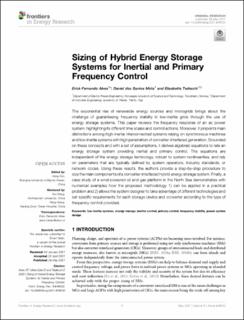| dc.contributor.author | Alves, Erick Fernando | |
| dc.contributor.author | Mota, Daniel dos Santos | |
| dc.contributor.author | Tedeschi, Elisabetta | |
| dc.date.accessioned | 2021-07-13T07:48:44Z | |
| dc.date.available | 2021-07-13T07:48:44Z | |
| dc.date.created | 2021-07-02T15:41:43Z | |
| dc.date.issued | 2021 | |
| dc.identifier.citation | Frontiers in Energy Research. 2021, 9, . | en_US |
| dc.identifier.issn | 2296-598X | |
| dc.identifier.uri | https://hdl.handle.net/11250/2764227 | |
| dc.description.abstract | The exponential rise of renewable energy sources and microgrids brings about the challenge of guaranteeing frequency stability in low-inertia grids through the use of energy storage systems. This paper reviews the frequency response of an ac power system, highlighting its different time scales and control actions. Moreover, it pinpoints main distinctions among high-inertia interconnected systems relying on synchronous machines and low-inertia systems with high penetration of converter-interfaced generation. Grounded on these concepts and with a set of assumptions, it derives algebraic equations to rate an energy storage system providing inertial and primary control. The equations are independent of the energy storage technology, robust to system nonlinearities, and rely on parameters that are typically defined by system operators, industry standards, or network codes. Using these results, the authors provide a step-by-step procedure to size the main components of a converter-interfaced hybrid energy storage system. Finally, a case study of a wind-powered oil and gas platform in the North Sea demonstrates with numerical examples how the proposed methodology 1) can be applied in a practical problem and 2) allows the system designer to take advantage of different technologies and set specific requirements for each storage device and converter according to the type of frequency control provided. | en_US |
| dc.language.iso | eng | en_US |
| dc.publisher | Frontiers Media | en_US |
| dc.relation.uri | https://zenodo.org/record/4601067 | |
| dc.rights | Navngivelse 4.0 Internasjonal | * |
| dc.rights.uri | http://creativecommons.org/licenses/by/4.0/deed.no | * |
| dc.subject | Energilagring | en_US |
| dc.subject | Energy storage | en_US |
| dc.subject | 22/5000 Kraftsystemet balansering | en_US |
| dc.subject | Power system balancing | en_US |
| dc.subject | Stabilitetsanalyser | en_US |
| dc.subject | Power system stability | en_US |
| dc.title | Sizing of Hybrid Energy Storage Systems for Inertial and Primary Frequency Control | en_US |
| dc.type | Peer reviewed | en_US |
| dc.type | Journal article | en_US |
| dc.description.version | publishedVersion | en_US |
| dc.subject.nsi | VDP::Elkraft: 542 | en_US |
| dc.subject.nsi | VDP::Electrical power engineering: 542 | en_US |
| dc.source.volume | 9 | en_US |
| dc.source.journal | Frontiers in Energy Research | en_US |
| dc.source.issue | 649200 | en_US |
| dc.identifier.doi | 10.3389/fenrg.2021.649200 | |
| dc.identifier.cristin | 1920139 | |
| dc.relation.project | Norges forskningsråd: 281986 | en_US |
| dc.relation.project | Norges forskningsråd: 296207 | en_US |
| dc.description.localcode | Copyright © 2021 Alves, Mota and Tedeschi. This is an open-access article distributed under the terms of the Creative Commons Attribution License (CC BY). The use, distribution or reproduction in other forums is permitted, provided the original author(s) and the copyright owner(s) are credited and that the original publication in this journal is cited, in accordance with accepted academic practice. No use, distribution or reproduction is permitted which does not comply with these terms. | en_US |
| dc.source.articlenumber | 649200 | en_US |
| cristin.ispublished | true | |
| cristin.fulltext | original | |
| cristin.qualitycode | 1 | |

